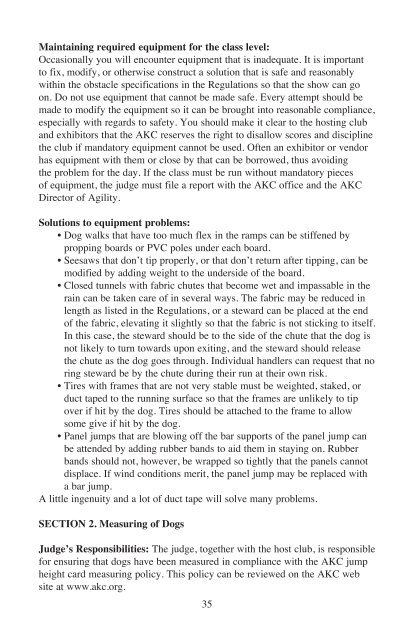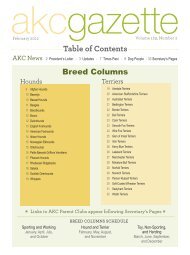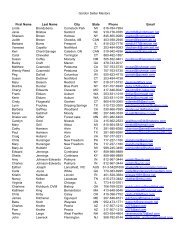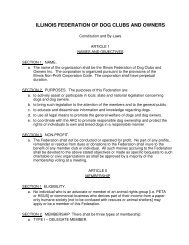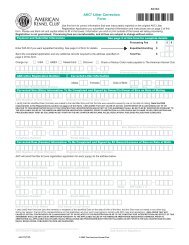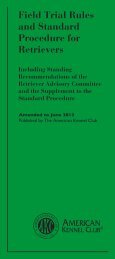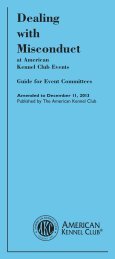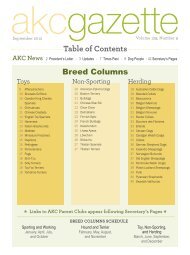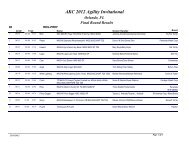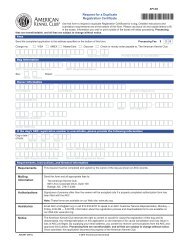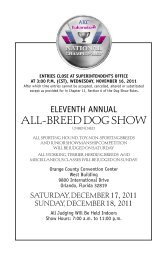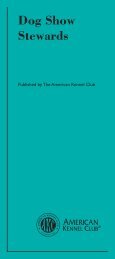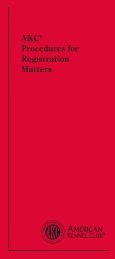You also want an ePaper? Increase the reach of your titles
YUMPU automatically turns print PDFs into web optimized ePapers that Google loves.
Maintaining required equipment for the class level:<br />
Occasionally you will encounter equipment that is inadequate. It is important<br />
to fix, modify, or otherwise construct a solution that is safe and reasonably<br />
within the obstacle specifications in the Regulations so that the show can go<br />
on. Do not use equipment that cannot be made safe. Every attempt should be<br />
made to modify the equipment so it can be brought into reasonable compliance,<br />
especially with regards to safety. You should make it clear to the hosting club<br />
and exhibitors that the <strong>AKC</strong> reserves the right to disallow scores and discipline<br />
the club if mandatory equipment cannot be used. Often an exhibitor or vendor<br />
has equipment with them or close by that can be borrowed, thus avoiding<br />
the problem for the day. If the class must be run without mandatory pieces<br />
of equipment, the judge must file a report with the <strong>AKC</strong> office and the <strong>AKC</strong><br />
Director of <strong>Agility</strong>.<br />
Solutions to equipment problems:<br />
• Dog walks that have too much flex in the ramps can be stiffened by<br />
propping boards or PVC poles under each board.<br />
• Seesaws that don’t tip properly, or that don’t return after tipping, can be<br />
modified by adding weight to the underside of the board.<br />
• Closed tunnels with fabric chutes that become wet and impassable in the<br />
rain can be taken care of in several ways. The fabric may be reduced in<br />
length as listed in the Regulations, or a steward can be placed at the end<br />
of the fabric, elevating it slightly so that the fabric is not sticking to itself.<br />
In this case, the steward should be to the side of the chute that the dog is<br />
not likely to turn towards upon exiting, and the steward should release<br />
the chute as the dog goes through. Individual handlers can request that no<br />
ring steward be by the chute during their run at their own risk.<br />
• Tires with frames that are not very stable must be weighted, staked, or<br />
duct taped to the running surface so that the frames are unlikely to tip<br />
over if hit by the dog. Tires should be attached to the frame to allow<br />
some give if hit by the dog.<br />
• Panel jumps that are blowing off the bar supports of the panel jump can<br />
be attended by adding rubber bands to aid them in staying on. Rubber<br />
bands should not, however, be wrapped so tightly that the panels cannot<br />
displace. If wind conditions merit, the panel jump may be replaced with<br />
a bar jump.<br />
A little ingenuity and a lot of duct tape will solve many problems.<br />
Section 2. Measuring of Dogs<br />
Judge’s Responsibilities: The judge, together with the host club, is responsible<br />
for ensuring that dogs have been measured in compliance with the <strong>AKC</strong> jump<br />
height card measuring policy. This policy can be reviewed on the <strong>AKC</strong> web<br />
site at www.akc.org.<br />
35


